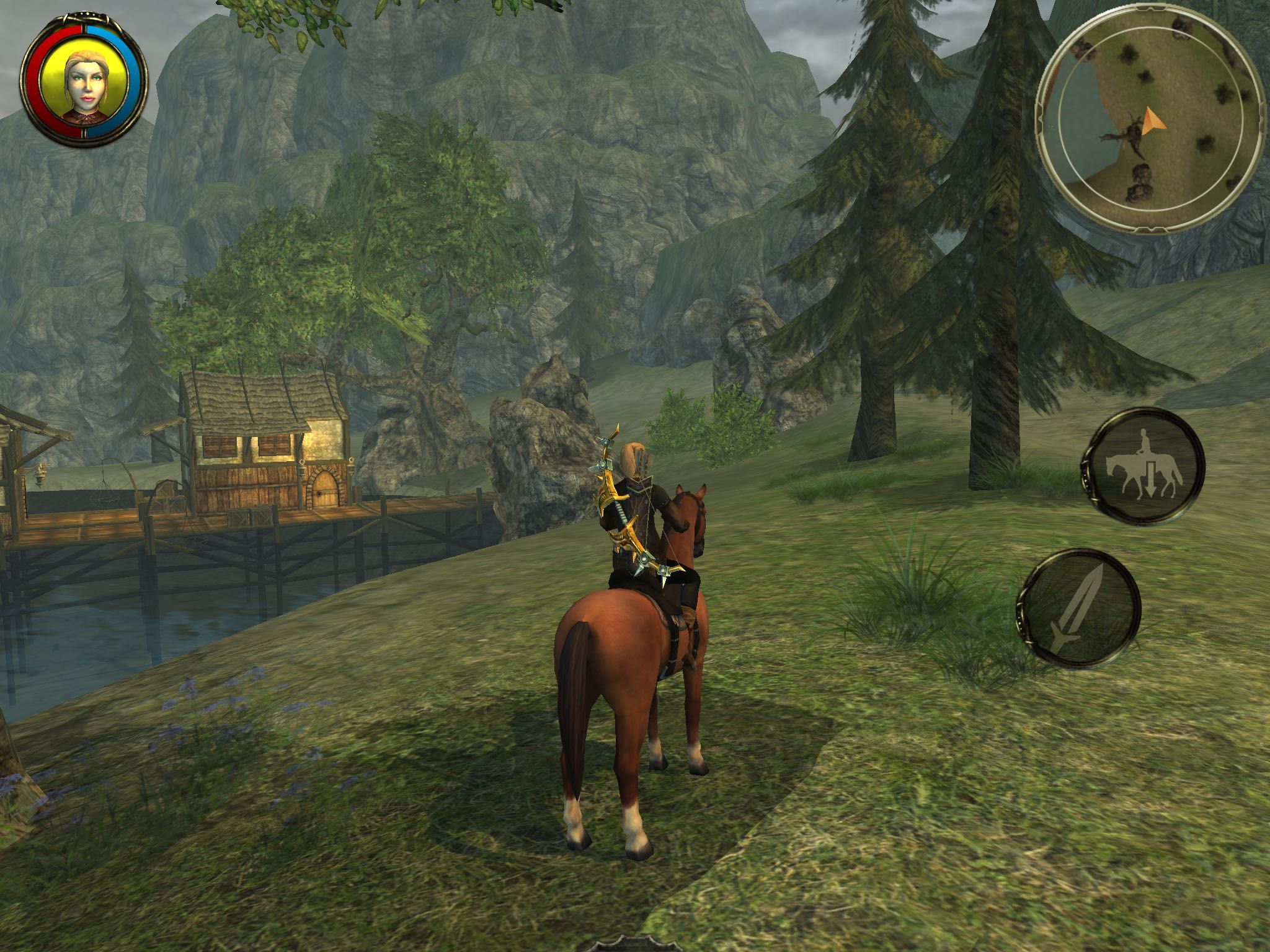 It seems like 2015 is the year of long-awaited games finally releasing. This year we’ve had Spider: Rite Of The Shrouded Moon (Free), Galactic Keep ($3.99), The Room Three ($3.99), and Dragon Fantasy: The Black Tome Of Ice ($9.99), among others, and it looks like we’re going to be ending the year with another game that’s been stewing for awhile: the follow-up to 2010’s Aralon: Sword And Shadow (Free), from Galoobeth Games and Crescent Moon Games. For its time, Aralon was almost unbelievable for a mobile game. Offering a big 3D world that felt considerably more detail, open, and alive than the one found in Crescent Moon’s previous title, Ravensword, Aralon felt like a big step towards having a fully-featured, modern, WRPG-style game on iOS. That was in 2010, however, and I’m sure I don’t need to tell anyone how the market and player expectations have shifted in the intervening half-decade. Aralon: Forge And Flame ($4.99) is stepping out into a much different world than the one that welcomed its predecessor, and it doesn’t quite have the sizzle to fill the footsteps it’s walking in.
It seems like 2015 is the year of long-awaited games finally releasing. This year we’ve had Spider: Rite Of The Shrouded Moon (Free), Galactic Keep ($3.99), The Room Three ($3.99), and Dragon Fantasy: The Black Tome Of Ice ($9.99), among others, and it looks like we’re going to be ending the year with another game that’s been stewing for awhile: the follow-up to 2010’s Aralon: Sword And Shadow (Free), from Galoobeth Games and Crescent Moon Games. For its time, Aralon was almost unbelievable for a mobile game. Offering a big 3D world that felt considerably more detail, open, and alive than the one found in Crescent Moon’s previous title, Ravensword, Aralon felt like a big step towards having a fully-featured, modern, WRPG-style game on iOS. That was in 2010, however, and I’m sure I don’t need to tell anyone how the market and player expectations have shifted in the intervening half-decade. Aralon: Forge And Flame ($4.99) is stepping out into a much different world than the one that welcomed its predecessor, and it doesn’t quite have the sizzle to fill the footsteps it’s walking in.
To be clear up front, this is not another situation like Exiles, Crescent Moon’s last promising action-RPG release, which fell flat for a variety of reasons. There are certainly bugs around in Forge And Flame, and I ran into at least one big one. There’s nothing that should impede your progress, however, and unlike Exiles, this game feels essentially complete. It’s fun, too, even if it is clunky in the way most of Crescent Moon’s 3D RPGs are. I have a ton of criticisms of its individual components, but the point remains that I was strongly engaged by Forge And Flame right up until the very end of the adventure. I can easily recommend it to anyone who enjoyed Crescent Moon’s previous games in a similar vein.
That’s basically the short version of this review of Aralon: Forge And Flame. It’s another Crescent Moon RPG, with all of the strengths and weaknesses you might have come to expect from them. A big, beautiful world? Yes. A somewhat lonely feeling to said world due to its overall emptiness? That, too. Enjoyable character progression both in terms of skills and equipment upgrades? You know it. Terribly awkward combat with weak enemy AI? Well, you get the idea. Crescent Moon’s games always feel a little more ambitious than the average small developer’s works, and that always has a cost, not just in terms of bugs and framerate issues, but also in how the game design shakes out.
Upon finishing Aralon: Forge And Flame, my overwhelming opinion was that this was a very safe sequel. In a lot of ways, too safe. I had a lot of fun, but I couldn’t help but feel this was a Mega Man-like sequel in terms of improvement, and that after five years, it ought to have been more than that. I had replayed the first Aralon several months ago for an RPG Reload, so the game was somewhat fresh in my mind. But I wanted to be sure that I wasn’t just remembering things incorrectly, so I fired up the original game again and played a few hours of it. I’m happy that I did, because it demonstrated some of the big differences between the two games. Forge And Flame has a far cleaner design overall, and it definitely shows off the experience the developers have gained in the interim years. Strangely, I’m not sure if that’s a good thing or a bad thing.
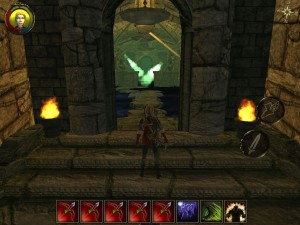
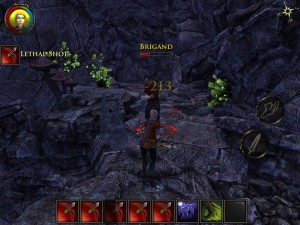
What is unambiguously good is the new user interface. The original Aralon often feels like it was a PC game that stumbled onto a touch screen device, with lots of little buttons and controls that get more awkward the bigger the screen you try to play on. Forge And Flame seems far more aware of the screen real estate and input devices it’s dealing with, making it a lot easier to do things you’ll need to do often, like opening up your sub-menus or using your special moves. Checking on your open quests or flicking through your inventory is as easy as pie. You can tap on things directly to interact with them rather than having to hit an action button, and movement only requires you to move your digit around on the left side of the screen, rather than jab at a virtual directional pad. My only real beef with the UI is when you’re in a shop. Maybe I missed something, but I didn’t notice a way to check the stats of shop items versus what I had equipped without leaving the shop menu, an action which shuffles some of the items out and brings new ones in. On the whole, though, this is a huge jump and the game is far better for it.
The over-arching design of the world and the quests found in it feels considerably more focused than the original game. It was as if the developers were more aware of their limitations this time around and built the game around them from the start. The world is open, yes, but it’s also designed in a very linear way, and a fairly good portion of it is gated off at the beginning. Everywhere you need to go is marked on your map, lined up roughly in the order in which you should visit them. There are fewer useless NPCs in the world, and I suppose fewer useful ones, as well. There are considerably fewer side-quests to embark on, and not as many inessential nooks and crannies. For better or worse, this is a much more focused and streamlined experience compared to the first game.
Virtually every quest in the game, mandatory or otherwise, involves collecting one or more of a particular item that is usually dropped by an enemy, talking to someone in one of the few towns, or killing a target. Early on, there are a couple of side quests that involve fishing or swimming, but after those are done, you’re either going to be talking to something or stabbing it. The latter naturally involves combat, and I’m afraid that’s still a weak point for Crescent Moon. Whether you’re getting up close with melee attacks or using ranged abilities like bows or spells, battles are lacking in both depth and impact. It doesn’t help that the enemy AI is completely brain dead. While exploring a magma-filled cavern, enemies on parallel walkways who spotted me would without fail charge directly at me, running right off their platforms into the gaping maw of liquid flame that sat between us. To beat the final boss, I simply put up a spike shield and let him hit himself to death, a tactic he was all too happy to cooperate with. It’s fun enough in a mindless way, but I can’t help but imagine how much better it could be.
Granted, part of my ease with the game’s battles might have come from scoring a lucky equipment piece early on. Most of the treasure in Forge And Flame is random, and even the shops seem to cycle in random gear pieces every time you talk to the keeper. Equipment is broken down into a few different categories for each type, with further modifications based on the quality of the piece. I got a pretty strong bow for my ranger almost as soon as I hit the first town just by searching a townsperson’s dresser, and it served me well until nearly the end of the game. It’s cool that something like that could randomly happen, even if it did have the negative effect of making almost every bow I found from then on worthless. Since my ranger only had access to special skills with bows, all the other weapons I found were mostly useless as well, and selling them ensured that I was flush with cash for much of the game. Not that there were many good places to spend it, mind you. After the second town, I never did see another shop in the game.
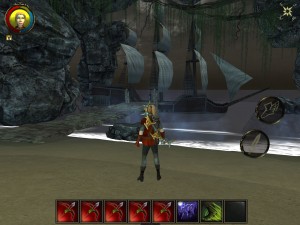

Lest I harp too much on the bad, let’s talk about some of the things Forge And Flame does well. I enjoyed the mandatory dungeons quite a bit, even if they were a little on the short side. With traps, mild puzzles, and interesting architecture, these dungeons were fun enough to explore that they overshadowed the mechanics not being quite up to snuff at times. The dungeons aren’t the only areas that look great. While it’s not as much of a looker relative to current mobile standards as its predecessor was, Forge And Flame is often very beautiful to look at. The framerate can get a little dicey at times, though, particularly when there are a lot of moving objects on-screen, and some details look pretty bad, like the way your hands hover above your mount, holding invisible reins. When you get scenes that look like the last overworld section of the game, a beautiful snow-covered range of mountains, it’s easier to forgive things like that.
I also appreciated how well-balanced the leveling was in the game. I didn’t need to stop and grind even once, and although I was able to fill out most of my ability tree by the end of the game, I couldn’t unlock and max out every ability, which adds a measure of replay value to the game. I completed almost all of the side quests, save one that I couldn’t complete due to an apparent bug, but I think even without them, I probably could have made my way through to the ending. Open world RPGs are notoriously hard to balance, so I was quite happy to see the developers pull it off so well in Forge And Flame. It probably errs a little too far on the easy side, but overall, progress through the game is smooth and satisfying.
I ran into a few bugs during my playthrough. My character’s name disappeared at some point, being replaced with a string title. There were a couple of caves that upon exiting would dump me out at the beach near the beginning of the game, a behavior I’m reasonably sure isn’t intended. There’s a sub-quest where you need to get some silk from a spider queen that I couldn’t find a way to resolve for the life of me. The occasional item appeared to be missing its icon, and some of the text occasionally spilled out of the dialogue boxes. Nothing too serious, to be sure, as long as you know to expect it. There were no game-stopping instances or any chicanery with save files apart from the renaming of my character.
The key to enjoying Aralon: Forge And Flame is in managing your expectations. It doesn’t immediately impress the way its predecessor did simply because technology has moved forward more quickly than this sequel has advanced. It’s empty and clunky in a way that was easily forgivable even a few years ago, but seems more antiquated now. I wonder if it’s even realistic to expect a more fully fleshed-out open world RPG given the state of the market. If you set all that aside and simply focus on what’s here, you’ll find a compelling, if somewhat rough, pseudo-action RPG with several hours of adventure on offer. It’s less ambitious than the first Aralon but more refined, with all the give and take that comes with that.
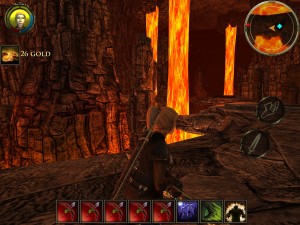
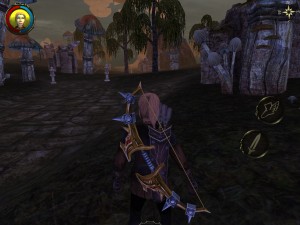
Taken as a complete experience, I enjoyed Aralon: Forge And Flame enough that I made my way through the game in only a few sessions. I can’t say I was completely satisfied in the end, but I had a lot of fun along the way, more than you might expect from my critical breakdown of the game’s various working parts. That’s the way it usually is with this kind of game, though, isn’t it? If you can overlook some flaws that have persisted through this whole line of games from Crescent Moon, you’ll probably enjoy this return to Aralon quite a bit. On the other hand, if you weren’t wowed by their previous efforts, you’ll likely be even less wowed with this game. Forge And Flame is quite good, especially considering its scope, but it’s not quite great.
